The simple answer is as hot as your oven will go!
People are often very surprised to hear this. However, in a traditional wood fired pizza oven, temperatures reach 500 degrees celcius (over 900 degrees farenheit)!
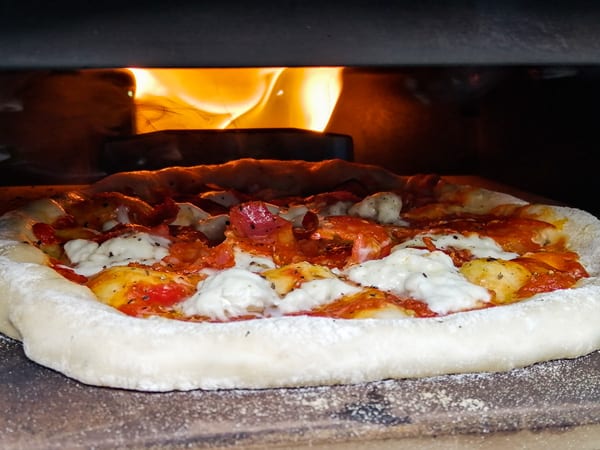

The average domestic oven will only get up to about 250 degrees celcius (about 500 degrees farenheit).
Of course, the cooking process will be a little different at these lower temperatures but if you want to get as close to possible to the real thing, you have to turn that oven up!
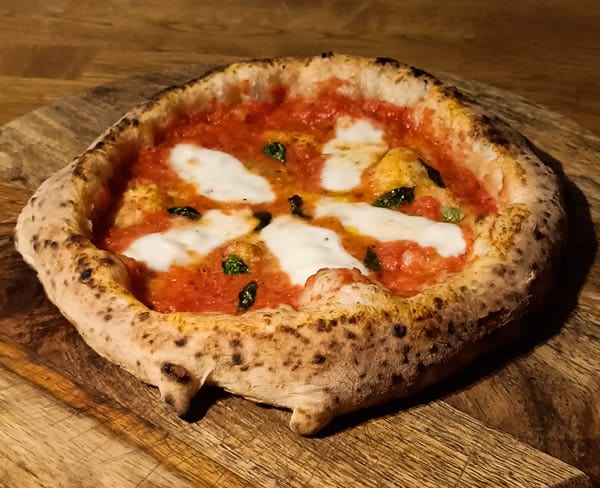
Therefore, the best temperature to cook homemade pizza in your domestic oven is about 250 degrees celcius (about 500 degrees farenheit). For gas mark ovens, this is about gas mark 9.
Also, if you have a fan assisted oven, make sure the fan is turned on. This will improve the airflow and increase the overall temperature inside the oven.
If you have a pizza oven at home then the best temperature will be a lot higher than 250 degrees, but I’ll discuss that in another post.
No, your oven won’t break when you turn it up as high as it will go.
All ovens, including domestic ovens, are designed and built with safety in mind. Even at its highest setting your oven will be well within its safe working temperature.
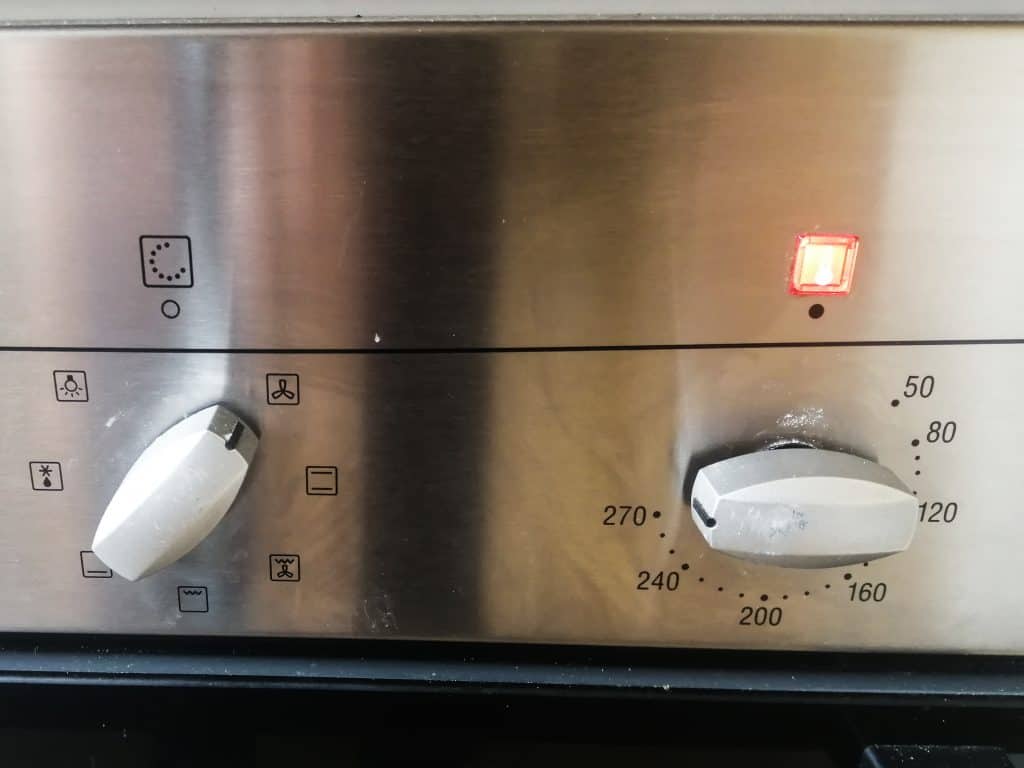
In fact, your oven may be limited by as much as 100 degrees! Oven manufacturers don’t want you hurting yourself or the oven breaking before its designed lifespan.
In short, cooking pizza at a high temperature makes the best pizza!
This is because:
If you have ever had a traditional pizza cooked in a wood fired oven then you will know what I’m talking about. The crust is crispy yet soft, the dough has depth of flavour, and the cheese and toppings are perfectly cooked. It really is heaven, right?
If you’ve ever considered getting a pizza oven, take a look at my article on whether pizza ovens are worth it here.
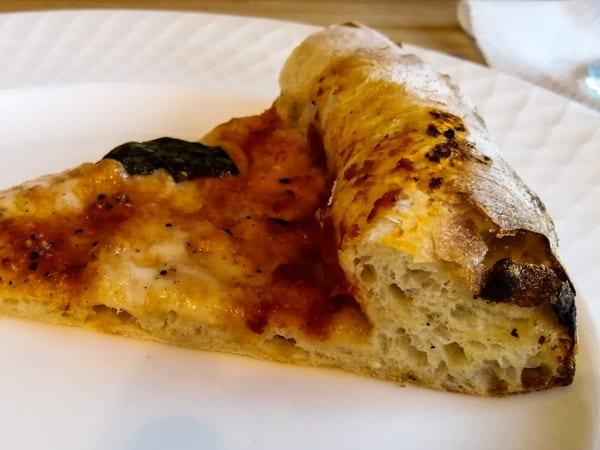
Fortunately, if you follow my advice you can still cook delicious pizza in a normal domestic oven.
Preheating your oven is an absolute must!
It is also important to preheat your oven with your baking tray or pizza stone inside. You should preheat your oven at maximum temperature for at least 30 minutes.
That’s right, 30 minutes!
I know this seems like a long time but it takes a while for your cooking surface to get up to temperature.
Whilst your oven may get up to temperature in about 10 minutes, your pizza stone or baking tray will take a lot longer.
A pizza stone, or baking stone, is basically a thick cooking surface for pizzas and bread. They are typically made from ceramic or stone. You can even get a pizza steel like this one on Amazon to cook pizzas on. These are typically more expensive but more durable.
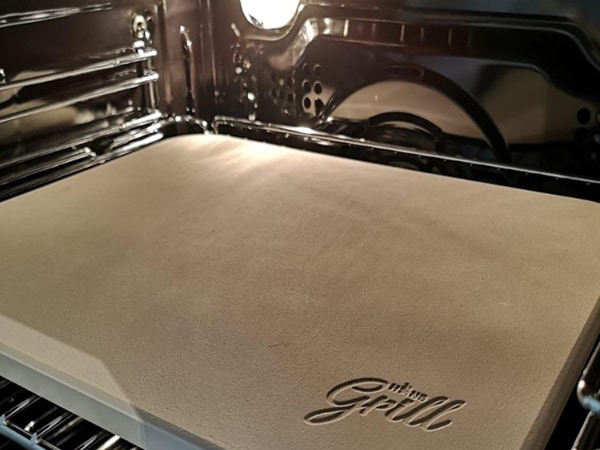
It is true that you don’t need a pizza stone to make nice pizzas.
However, a pizza stone can significantly improve the quality of your pizzas. With a pizza stone/steel, you will be able to achieve a crispier base and crust.
The great thing about a pizza stone is that it holds its heat extremely well.
As soon as your pizza hits the cooking surface it will reduce the temperature of the surface. This is especially true of a normal baking tray.
Because a pizza stone is so thick and efficient, the drop in temperature will be much lower than a regular baking tray. This allows your pizza to cook much more evenly and enables you to achieve that all important crispiness.
It’s impossible to write a post about the best temperature to cook a homemade pizza without mentioning a pizza stone! I can highly recommend getting one, and if you intend on cooking loaves of bread anytime, it’ll come in handy for that too.
If you don’t have a pizza stone, use the back of a baking tray. Turning the tray upside down will make it easy to get your pizza on and off it, and will work just as well, if not better.
Using a laser thermometer is particularly helpful when using a pizza oven, but it is also useful for a normal oven. 260 degrees Celsius (500 Fahrenheit) is the hottest that I can get my oven.
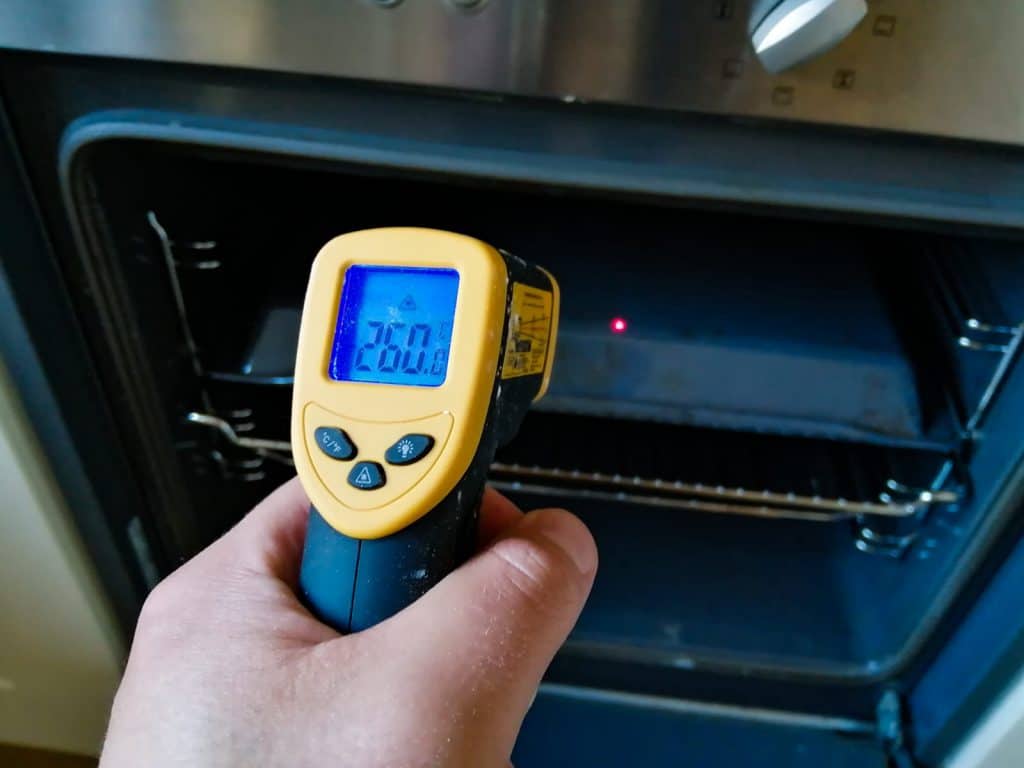
Don’t be tempted to put your homemade pizza straight on the grill rack. Shop bought pizzas that have been pre-cooked may cook OK like this but fresh dough pizzas will not.
Fresh pizza dough needs a flat, hot surface to cook properly. Also, your pizza won’t stick to the rack and you won’t get cheese dripping into the bottom of your oven.
When you use a baking tray for the first time, it is a good idea to lightly flour it. This will ensure that your pizza does not stick to the tray.
The best place to put your pizza stone or baking tray is typically where your oven is the hottest.
For the vast majority of domestic ovens, this is the top of the oven. However, your oven may be different.
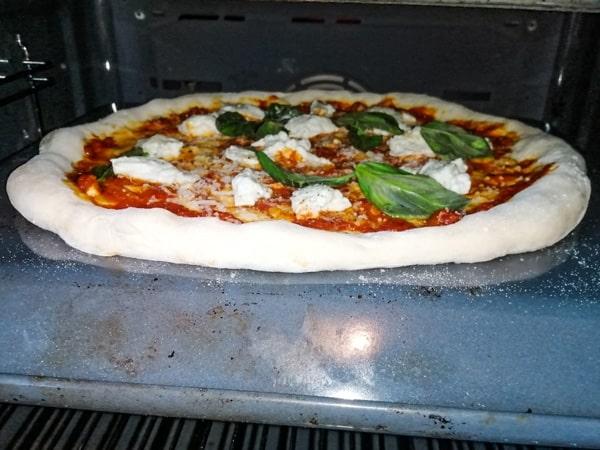
To start with, I would go for about 6 inches from the top but feel free to experiment to see what works best for you. You may find that moving your pizza down a little will give you a more even cook.
I’m going to assume that you have got the pizza shaped. This is an incredibly important stage and should be carried out with great care! Check out my article (with a video) on pizza shaping here.
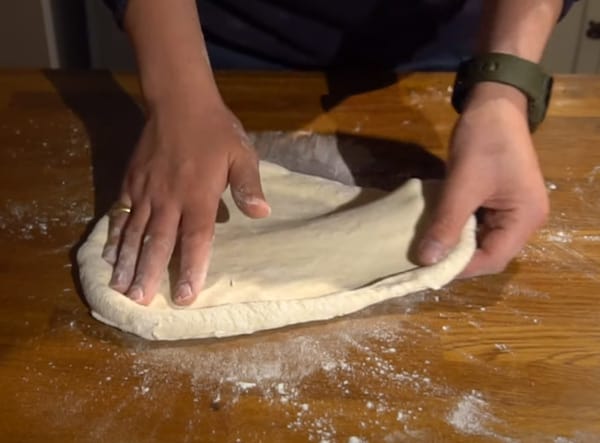
Once you have got your oven preheated and your pizza shaped, we can start thinking about getting it in the oven!
However, as soon as you open the oven door to put your pizza in, the temperature will start to drop.
It’s important to get the pizza inside the oven as quickly as possible, before it cools too much. Try to minimise the time the oven door is open by making sure you are prepared beforehand.
My best advice here, is to make sure your pizza is loaded on a pizza peel before you open the oven door.
A pizza peel, or baker’s peel, such as this peel on Amazon, is a wooden board or metal plate with a handle. They are used to load pizzas or loaves of bread into and out of the oven.
Peels make it easy to quickly transfer pizzas to the cooking surface, without effecting the shape of the pizza, or burning yourself!
In fact, with traditional Neapolitan pizza, the pizza is stretched again as it is dragged onto the peel. This happens after topping the pizza, and just before it is loaded into the oven. You can check this out in my article on shaping (with a video) here.
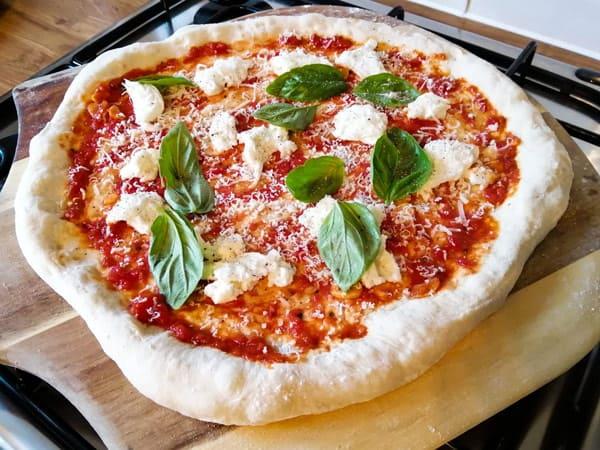
A pizza peel is a great investment but you don’t need one.
If you don’t have a peel, I recommend using a chopping board. Wooden or glass chopping boards are best for this. I wouldn’t advise using a plastic one as it may melt as it touches the hot surface.
Make sure you lightly flour your peel or chopping board to avoid the pizza sticking to it.
It is difficult to give the exact time it takes to cook your homemade pizza but as a rough guide, it usually takes about 6 – 10 minutes in a regular domestic oven.
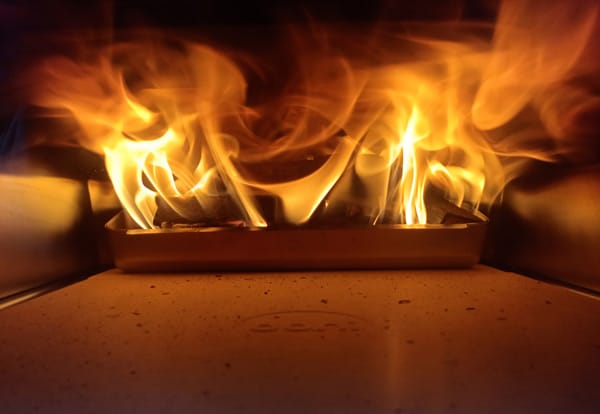
The cooking time will depend on a number of factors, including:
Unfortunately, I do not have an exact answer and it mainly comes down to trial and error. You will need to figure out what your oven is capable of and how it cooks homemade pizza.
The best advice I can give you is to stay at the oven whilst your pizza is cooking and keep checking it. Try to avoid opening the door too much, however, as this will cause the temperature inside the oven to drop.

If your oven door has a window, then you can easily check the pizza through this.
Timing your pizza is helpful for future reference. I recommend leaving the oven door shut for at least 4 – 5 minutes initially. This will ensure that the base cooks properly.
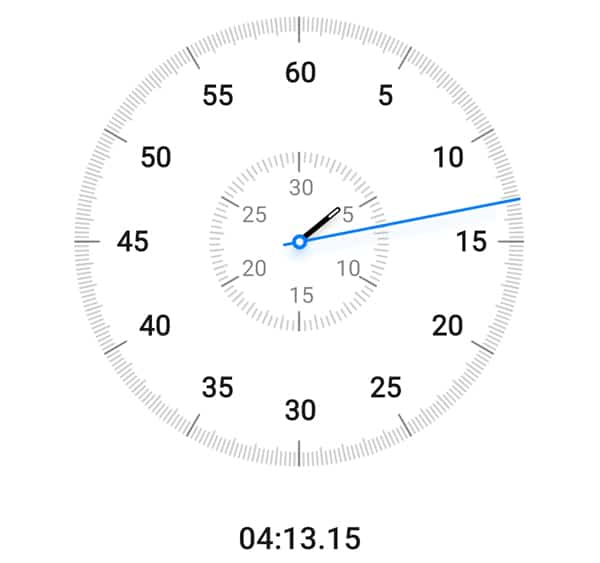
After 4 – 5 minutes, the pizza should be mostly cooked but it will probably need turning 180 degrees to make sure it is cooked evenly.
Usually the pizza cooks more at the back of the oven but your oven may be different. You may find that the pizza cooks more on the left or the right.
It’s amazing how much you learn about your oven when cooking pizza!
You can turn the pizza as much as you want toward the end of the cooking to try get it as even as possible. Remember not to leave the oven door open though!
There are 2 ways to tell when your homemade pizza is cooked:
The problem with checking the colour of the crust is that every oven will yield different results. Until you know how your oven cooks pizza, it’s impossible to know how your pizza looks when it’s cooked.
My favourite way of telling when the pizza in cooked is by feeling the crust. You can do this every time you turn the pizza, it only takes a second.
The cooked pizza crust should be very firm and crispy. Once the pizza is removed from the oven and it starts to cool, the crust will soften slightly so don’t worry about it being too crispy.
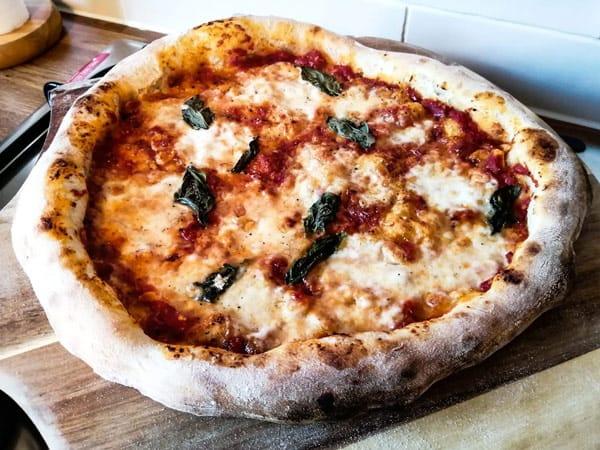
Of course, it is possible to cook a pizza too much, it will take some trial and error. It’s hard to say exactly how to tell when it’s right, but you get a feel for it the more you cook pizza.
Let it cool a little once it comes out so that that the crust can soften, and so that you don’t burn your mouth! Cool pizza is always better than red hot pizza, trust me!
Take a look at the simple steps below to find out how to make great homemade pizza from start to finish! Also, be sure to check out my Authentic Neapolitan pizza recipe here.
Remember, the best temperature to cook your homemade pizza and how long it will take is something you’ll have to figure out on your own. But hopefully I’ve got you on the right track, and saved you a lot of time and effort in the long run.
For more information on every step in the pizza making process, check out my Pizza School Series (with videos) here.

Here are the basic instructions for cooking homemade pizza in a regular domestic oven. For dough recipes, check out my super easy no knead recipe here and my Authentic Neapolitan recipe here.
Not all the following utensils are required but these are what I use and they tend to make the process easier. I’ve provided Amazon links for you to check the prices of these items if you don’t have them already. They are usually available for reasonable prices.
Difficulty: Easy/Medium
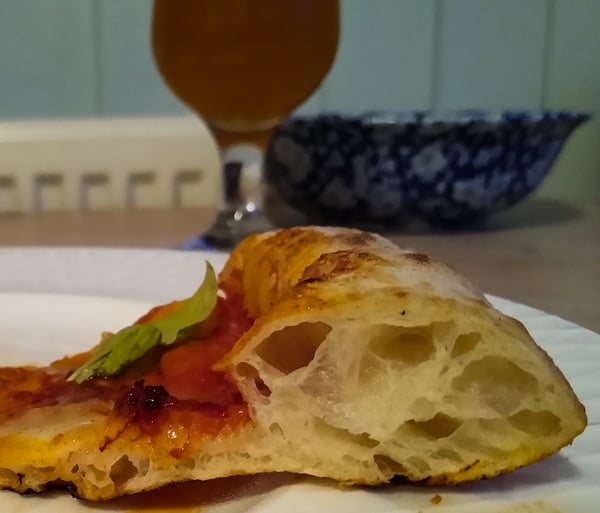
Check out my easy no knead dough recipe here
Making great pizza really isn’t that difficult so give it a go, you amaze yourself!
Check out my easy no knead pizza dough recipe here. This is a pizza dough that requires no kneading whatsoever! It’s super easy!
If you fancy diving in at the deep end, check out my authentic Neapolitan pizza recipe here. This recipe is slightly more challenging but it’s still not too difficult, and it’s really fun!
There’s no time like the present, for amazing pizza! Let’s get mixing!

I’m Tom Rothwell and I’m super passionate about all kinds of homemade pizza! In the last few years I've been on a quest to find the perfect pizza. Now I'm sharing what I've found out with the world!
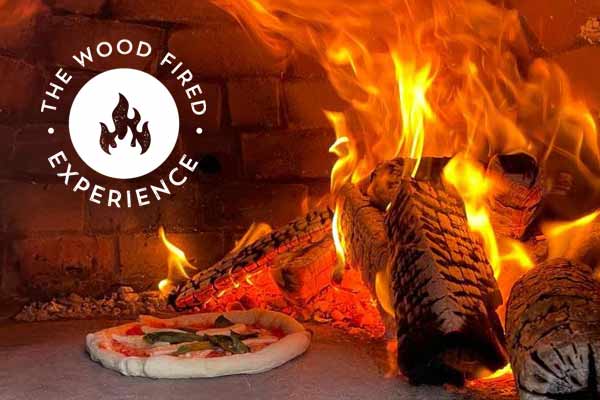
If you're interested in hiring me for your event in the UK, feel free to check out my website with the link below.
Pizza Catering
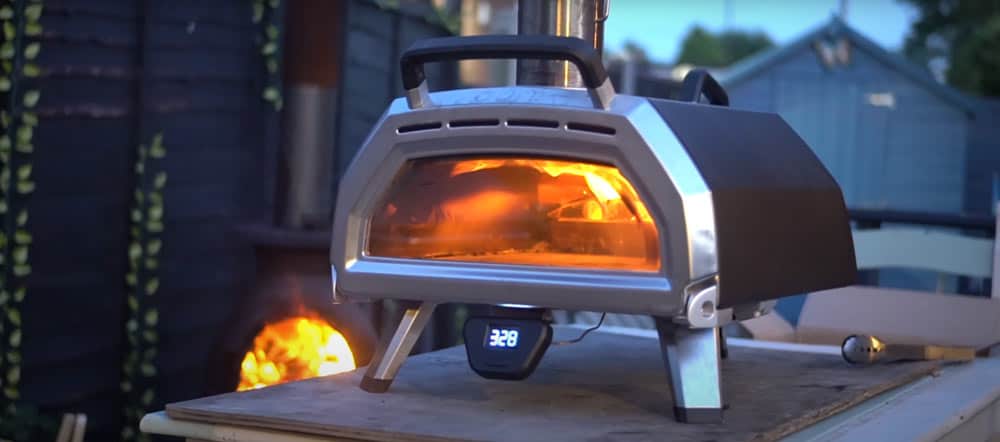
I often get asked what type of oven I use for my pizzas. Well, I use a pizza oven made by a company called Ooni.
The range of pizza ovens that Ooni offers is just brilliant. They cover all bases, and all price points. There's affordable and portable models such as the Fyra 12 Pizza Oven and then there's state-of-the-art models such as the Karu 16 Pizza Oven pictured below.
In all honesty, I would say that the oven makes a huge difference. If you're looking to make authentic Italian pizza, a pizza oven is a must.
By clicking the link below and purchasing from Ooni, you would be supporting this website. I've been using their ovens for a long time now and I wouldn't recommend them if I didn't believe in their products.
Time to make some amazing pizza!

I’m Tom Rothwell and I’m super passionate about all kinds of homemade pizza! In the last few years I've been on a quest to find the perfect pizza. Now I'm sharing what I've found out with the world!

If you're interested in hiring me for your event in the UK, feel free to check out my website with the link below.
Pizza Catering
If my oven can go to 550f do you still suggest only 500f?
Hi Vincent. I would cook the pizza at the highest temperature your oven can reach. If your oven goes to 550F then I would try cooking at that temperature. Good luck!
My dad would like to have pizza for our lunch tomorrow, which is why I’m currently looking for some recipes. Well, I’m glad you shared these tips; I’ll make sure to turn off the fan because according to you, this will help improve the airflow in the oven. Anyhow, maybe it would be best to look for a pizza restaurant first since I haven’t perfected the recipe yet.
Hi Rachel, turning the fan on will help with airflow and temperature. I’ve made some excellent pizzas in a fan assisted oven at the maximum temperature of about 260C/500F.
Good luck!
Can I pre-cook my pizza dough without the toppings and then add the toppings at the end? Because every time I cook my pizza the dough comes out a bit raw and the toppings fully cooked even though my dough would be extremely thin.
Hi Mariane, good question. If you find your toppings are burning in your home oven you can try pre-cooking the base for around 1-2 minutes before adding the toppings.
This should prevent the toppings from burning. You’ll need to experiment with the timings since every oven cooks slightly differently.
Just be sure to preheat your oven (and the tray/stone) to the maximum temperature each time.
Good luck!
Hi Tom.
After having shaped and topped my pizza it was too soft to slide onto the peel. So I had to fold it & sort of man handle it into the oven.. ended up with a kind of calezone! How do I over come this problem.
Hi Phil
You could use a little less water (or more flour) next time to make a drier dough. This should make the pizza stronger and more forgiving to work with. I generally recommend a hydration (water content) of around 56%-60% which tends to be lower than what most people start out with.
The other important factor is speed of topping. Once the pizza is shaped, it needs to be topped in about 30 seconds. If the pizza is left longer than this, there is a risk of it sticking to the side and stretching too much, especially when loading on the peel.
Make sure you have all your toppings ready to go on the pizza before shaping. Then shape quickly (about 30 seconds) and top it quickly (about 30 seconds), then load it onto peel and launch it into the oven quickly (less than 30 seconds).
This should ensure that the pizza doesn’t stick to anything and doesn’t become weak or lose it’s shape.
Hope that helps and good luck!
Hi, I have a standard home oven which goes to 230 degree Celsius. Can I expect some good pizza from it. Should I use higher hidration and higher time to cook. I use a thick piece of ceramic tile as my stone. Pizza stones are a difficult to find in India. And yes should I cook my pizza twice, like once without topping and then adding the toppings.
Hi Aditya, thanks for the question. Yes, you can expect good pizza from your oven. I think almost any oven has the potential to make good pizza, but it will probably require some experimentation (which is fun anyway!).
I wouldn’t use a higher hydration since pizzas with higher hydrations are more difficult to shape. For this reason, I would stick to a lower hydration (around 56%-60%) to begin with.
Concentrate on getting your shaping as good as possible as this has a massive effect on the quality of the pizza. Even if you have great dough, you can’t have great pizza without good shaping!
Try to get the pizza as thin as possible in the middle as this will help it cook better. But try to keep some air in the crusts as this will lead to a lovely texture in the crust. Finally, try to get the pizza as round as possible as this will allow an even cook.
Feel free to check out my srticle (with a video) on pizza shaping here.
Your thick ceramic tile should work perfectly! Good pizza can even be made on a thin baking tray and your ceramic should certainly be better than this (since ceramic retains heat better).
In terms of cooking time, at 230C/450F, I would expect the pizza to take around 6-9 minutes to cook. I know this is a broad range but it will depend on your specific oven and how close your pizza is to the cooking element. Again, you will need to experiment with placement to see what works best in your oven.
You will also probably need to turn the pizza 2 or 3 times, every 2-3 minutes (to get an even cook).
With regards to your last point, about cooking twice, I think you will need to experiment. At lower temperatures, the top of the pizza tends to cook faster than the bottom. This is why cooking twice can help in lower temperature ovens.
I would try cooking with just tomato sauce for 1-2 minutes (as without any sauce the pizza is likely to puff up like a chapati!). Then you can remove the pizza and add the rest of the ingredients (including a little olive oil as the tomato will have dried up slightly). You may also find that adding a little additional tomato sauce at this stage helps to retain some moisture.
Then you can cook the pizza until the crusts (and base) are cooked through. If the toppings are over or undercooked then you can adjust the first cook accordingly.
I hope this helps. It’s not that complicated really, it just takes some trial and error!
Also, I’m pleased you’re cooking pizza in India. I have to say that Indian food is amongst my favourite, but I enjoy experimenting with all different cuisines.
Let me know how you get on, and good luck!
Thanks for the reply . I will try 60 percent this weekend, will definitely let u know how it turns out to be. And ya in India we get those small ovens which don’t go to very high temperature. I would have got a bigger one but I am 16 so I will have to convince my parents.
Hi there, sorry I am a bit late. I tried my pizza dough with 60per hydration. It seemed so good to work with, I think I was making 75 or 80 earlier. As the oven is not too hot I didn’t get get any browning on the crust but it was quite crispy. But I need help in just one thing. The base had a layer of flour on it after my pizza was ready. Was it because I used too much flour while shaping. Any tips for that would be great. Should I cormeal with the flour?
Hi Aditya, I’m glad you enjoyed the 60% dough. I agree, it’s a joy to work with, especially if you’re used to 75% hydration!
To answer your question, yes I would use a little less flour. You only need to use as much flour as needed, the less you can use the better. Excess flour on the base will burn in the oven.
Be sure to check out my article and video on shaping here. Hopefully following that method should help you to reduce the flour.
Also, I wouldn’t recommend cornmeal personally. I have found most cornmeals tend to burn more and give a strong flavour too. Some people may like it but others may not.
In my view, the best thing to do is to buy a high quality italian 00 pizza flour, such as Caputo. This type of flour is designed to withstand high temperatures and will not burn as much as most regular flours (even 00 ones).
Hopefully this answers your question. Good luck!
Hi I’ve just made my first pizza using a pizza stone, oven at 250C, as suggested, for 5 minutes, turned around and cooked further 3 minutes
Looked spectacular, flavours were very good
Only disappointment was that the dough was a little tough
Any suggestions what might have gone wrong?
Hi Angela, I’m glad you pizza turned out well.
Tough tough could be caused by a number of things. Usually it’s due to underproving so next time you could prove for longer or use a little extra yeast. Check out my pizza dough calculator here which should help with that.
Also, be sure that your dough is nice and bubbly and has doubled in size before shaping. If it hasn’t risen much, leave it longer or use a little more yeast next time.
It could also be due to overcooking, though it doesn’t sound like this is the issue.
The final thing I would try changing, after you’ve tried the other options, is increasing the hydration. Using a little more water in the dough can help to produce a softer dough but use too much and your dough may lack strngth and will be difficult to shape.
Check out my article on hydration here to learn more about that.
Hopefully this has helped out. Good luck!
Hi, I’ve made a pizza many times with my new fan assisted oven which is capable but it turned very bad! It was thin and tough. But today I read all of your information about it and appreciate it as it was so useful. I’m gonna try it this time as you explained. Thank you!
But I have a problem with the temperature, it is 250C. Shall I put it in at that high temperature?
Thanks
Hi Tavga, yes that temperature should make great pizza. In a pizza oven the temperature reaches almost 500C/900F so 250C is no problem!
Be sure to preheat your stone for around 30 minutes first to ensure it is up to temperature.
Good luck!
Hey Tom,
Great friggin site! Anyway, when cooking on my stone in my conventional oven (with fan) I usually have two stones… one above and one that I put the pizza on.
I’ve always pre-heated at 550F and before putting the pizza in turn the broiler on for 2-3 minutes prior and then put it in.
Have you done/recommend this method? Seems to work.
Hi Rob, I haven’t tried this method but if it works then why not?!
I normally just use my pizza oven and when I have used a normal oven, it’s always turned out well without using the broiler so I haven’t bothered experimenting with that.
Thanks for the comment though, this may be useful to others!